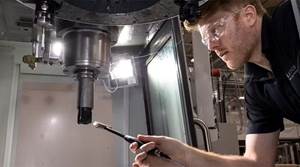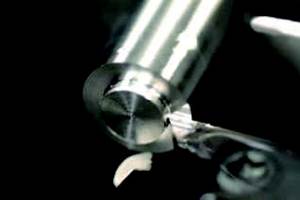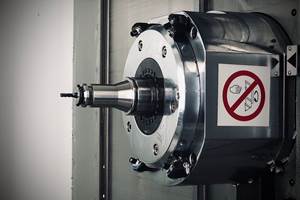The Part Is Longer Than The Lathe
Here is one custom machine builderŌĆÖs system for producing a 40-foot part that has to be passed through the turning center and out the other side. INCLUDES VIDEO.
Share





The bar feed is usually thought of as a device for machining many parts from a length of stock. The lathe cuts the bar into pieces (specifically, into workpieces) as the bar feed incrementally advances the stock into one machining cycle after another.
But imagine the bar feed instead as a device for allowing the lathe to handle a single very long partŌĆöa part many times longer than the lathe itself. The bar feed passes the part through the lathe and out the other side, so the lathe can machine it as it goes. An arrangement like this would require a bar unloader that is just as long as the bar feed to receive the part on the other side.
J.F. Berns recently engineered such a system. The company is a specialty machine builder and bar feed accessory supplier in Cincinnati, Ohio. The bar feed and bar-unloading system it engineered around a customerŌĆÖs turning center
accommodates parts measuring 7/8 to 2-1/2 inch in diameter and as long as 40 feet.
The long parts are heavy tubes made of steel. They serve as links in a system that carries electronics cabling deep into oil wells. Each of these machined links requires turning work at each end and cross-hole drilling all along the length. Thanks to the custom system, a 40-foot workpiece can be machined on an Okuma Macturn 350W turning center that has a maximum distance of 76 inches between the main spindle and subspindle. In other words, no more than about 15 percent of the part is in the machine tool at any one time. According to J.F. Berns president Joe Berns, ŌĆ£Supporting the work at this length is one thing, but feeding and supporting it is something else.ŌĆØ
Push And Pull
The system feeds the long work in three stages:
1. Within the bar feed, the first of two servo-driven pushers advances the work through the machine toolŌĆÖs main spindle and into the workzone. The pusher stops when the end of the part reaches through the main spindle and into the machine just far enough for the opposing subspindle to grab it.
2. The subspindle feeds close to the main spindle to clamp the end of the part. The subspindle then feeds away to pull the part farther into the workzone, and machining is performed on the length that is pulled inside the machine. The subspindle then releases the part, advances toward the main spindle to clamp the bar down farther still, and feeds out to pull the next section into the machine. Machined section is pushed out into the unloader by the subspindleŌĆÖs motion. Machining keeps proceeding in this wayŌĆöthe subspindle performing clamp, pull, release, clamp, pull, releaseŌĆöuntil the end of the part is reached.
3. At the end of the part, no stock is left for the main spindle to grip. The subspindle therefore canŌĆÖt draw the part the rest of the way through by itself. So a second pusher cycles into position within the bar feed. This pusher has a rod attached, with a head sized to the diameter of the bar. The rod is long enough to reach all the way through the workzone and through both spindles, pushing the work the rest of the way through the subspindle and entirely into the unloader.
Short Parts, Too
If it werenŌĆÖt for the length of the second pusher, then one pusher would be sufficient, says Gary Wildt. Mr. Wildt is J.F. BernsŌĆÖs engineering manager. The system could work with only one pusher, but then the need for the long rod in stage 3 would increase the length (and floorspace) of the overall bar feed system. The two-pusher approach allows the long pusher to be kept to one side of the work and used only when most of the part has already passed into the lathe.
The pusher with the long rod also enables this system to accommodate short workpieces, he says. That was another requirement of the system: It had to accommodate not just the 40-foot bars, but a range of bar sizes down to a length of just 3 feet.
Mr. Berns did the control and programming work. He says the Okuma machineŌĆÖs THINC control made the overall system considerably more versatile and error-proof than it otherwise might have been. The bar feed and a high-pressure coolant system from Chipblaser both interface with the control. Another CNC might have offered more restrictive data connections, he says, which would have forced him to minimize how much information he allowed the machine and bar feed to share. But the openness of the THINC system allowed him to capture liberal amounts of data, including status and position feedback throughout the cycle.
As a result, redundant systems confirm that (for example) the entry of the bar unloader has safely extended to its proper position relative to the current position of the subspindle.
The amount of position feedback also lets him enable the bar feed and the lathe together to resume machining from any interim point in the cycle. This saves time, he saysŌĆöallowing the operator to recover from a tool break or similar fault without having to re-run the entire part from the beginning.
╠²
Related Content
Orthopedic Event Discusses Manufacturing Strategies
At the seminar, representatives from multiple companies discussed strategies for making orthopedic devices accurately and efficiently.
Read MoreHow to Mitigate Chatter to Boost Machining Rates
There are usually better solutions to chatter than just reducing the feed rate. Through vibration analysis, the chatter problem can be solved, enabling much higher metal removal rates, better quality and longer tool life.
Read MoreToolpath Improves Chip Management for Swiss-Type Lathes
This simple change to a Swiss-type turning machine’s toolpath can dramatically improve its ability to manage chips.
Read MoreHow to Troubleshoot Issues With Tool Life
Diagnosing when a tool is failing is important because it sets an expectation and a benchmark for improvements. Finding out why gives us a clue for how to fix it.
Read MoreRead Next
Last Chance! 2025 Top Shops Benchmarking Survey Still Open Through April 30
Don’t miss out! 91╩ėŲĄ═°šŠ╬█'s Top Shops Benchmarking Survey is still open — but not for long. This is your last chance to a receive free, customized benchmarking report that includes actionable feedback across several shopfloor and business metrics.
Read MoreAMRs Are Moving Into Manufacturing: 4 Considerations for Implementation
AMRs can provide a flexible, easy-to-use automation platform so long as manufacturers choose a suitable task and prepare their facilities.
Read MoreMachine Shop MBA
Making Chips and 91╩ėŲĄ═°šŠ╬█ are teaming up for a new podcast series called Machine Shop MBA—designed to help manufacturers measure their success against the industry’s best. Through the lens of the Top Shops benchmarking program, the series explores the KPIs that set high-performing shops apart, from machine utilization and first-pass yield to employee engagement and revenue per employee.
Read More























